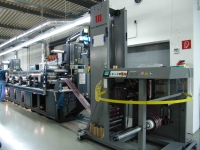Martin Automatic Powers Energy Savings
Posted: December 02, 2012
GEWA Etiketten GmbH, one of the leading German wine and spirit label printers, based in Bingen, has come up with a new way of attracting investment support from the German government by demonstrating its capability to reduce energy consumption. The scheme, which was instigated at GEWA by Production Director, Uwe Refflinghaus, and monitored by Klaus Wilhelm Bohr (Dipl.-Ing), involved the independent Ingenieurbüro Kautz from Darmstadt.
The target was to reduce energy consumption across GEWA's machine park of offset and narrow web flexo presses. If the company could demonstrate a reduction in power consumption of more than 20%, it would qualify for special terms with the KFW Bank as part of an official government scheme.
The presses chosen for the test were a Gallus EM 340 six-colour line and a Gallus RCS 330 all-servo press fitted with eight stations. On both machines GEWA had elected to fit Martin Automatic MBSC unwind/splice and STR rewind units to allow continual operation. The idea was to measure the difference in power consumed over the entire print run, when the rolls were changed manually and automatically.
The test involved a different job on each machine, chosen as being of medium difficulty, and run over half a day. There were eight points on each press where measurements were taken of the power consumed by the press itself and the UV curing and cooling systems, as well as other ancillary equipment like waste extraction. The jobs were based on three rolls of 2000 linear metres each, so included two roll changes. Set up time was obviously identical for each machine, whether using the Martin equipment or not. The two machines then ran and completed their respective jobs, first with manual roll changes and then using the Martin Automatic equipment.
The results were striking! Not only was there an average of 23% power saving per job, beating the 20% target, but they were finished significantly quicker, freeing the presses and operators to begin work on the next order. The statistics recorded were then calculated for jobs per shift, running time, and material used, and then grossed up for annual production, working on a double-day shift pattern on 250 days per year.
On power savings alone, GEWA calculated that on the two machines the Martin equipment reduced costs by €10,000 per year. If waste savings are added in, based on metres of substrate bought against metres sold, this equates to approximately €100,000 per year on the special label stocks used by the company.
"One of the hidden benefits of automatic roll changing is the improved quality of product. Continuous running eliminates the bad material produced while slowing the press down for a manual roll change and ramping it back up to production speed. This also saves time and money on downsteam processes like inspection/rewind," comment Refflinghaus.
Targeting waste reduction was key for GEWA, which calculates that in 2010 the company threw away the equivalent of 419 tonnes of substrate (1200 pallets). The 2011 target is to reduce this by 55 tonnes (145 pallets), which at sales value, amounts to €750,000.
Justifying his company's decision to invest in automated roll handling, he said: "On a roll fed press where production is on a continuous web of substrate it makes no sense to stop the press for roll changes. It's less efficient, lowers net output, and reduces quality. Since installation, the Martin equipment has run like clockwork."
GEWA employs 165 staff across two sites, and has an annual turnover of €22m, split between sheet fed offset 48%, roll fed offset and flexo 48%, and imprints 4%. The majority of its work is for the German wine market, for which it is ideally situated, being surrounded by vineyards!

